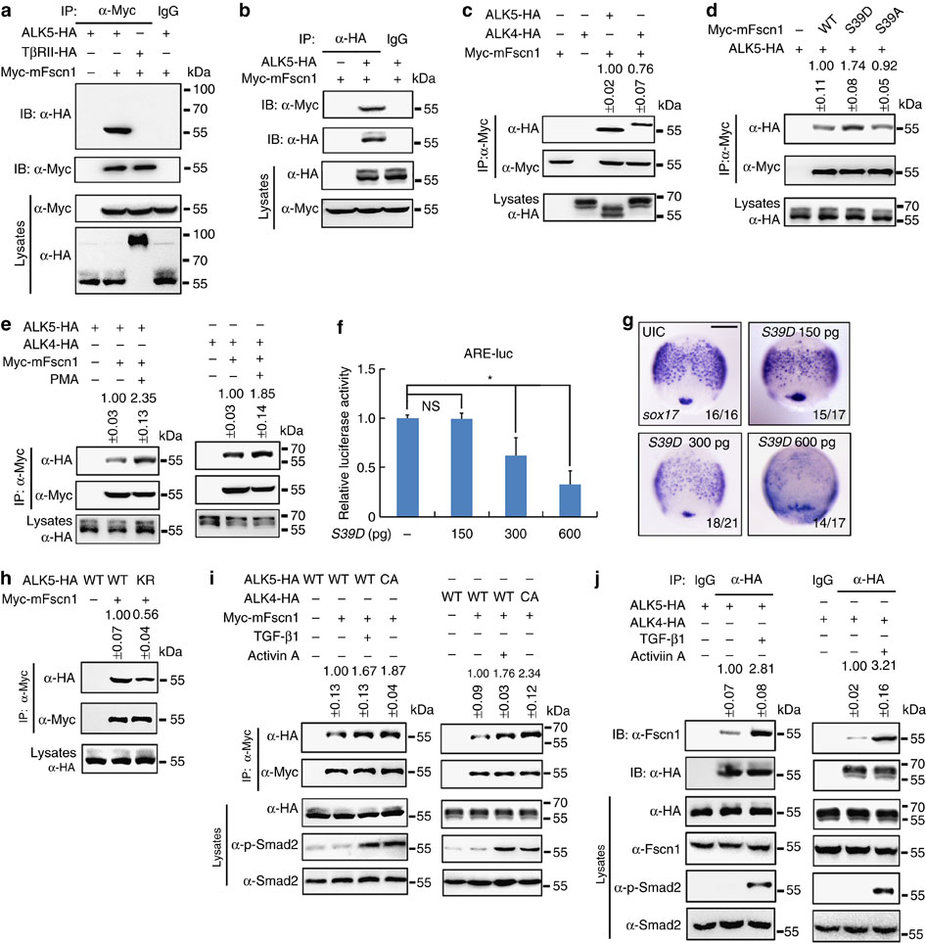Fig. 5
Fscn1 interacts with TGF-β family type I receptors.
(a,b) Fscn1 interacts with TGF-β type I receptor ALK5. HEK293T cells were transfected as indicated with expression plasmids encoding Myc-tagged Fscn1 and HA-tagged- ALK5 or TGF-β type II receptor (TβRII) and collected for immunoprecipitation with anti-Myc (a) or anti-HA antibodies (b). (c) Fscn1 also associates with Nodal type I receptor ALK4. HEK293T cells transfected with the indicated constructs were subjected to immunoprecipitation. (d) Fscn1 S39D shows a stronger binding affinity for TGF-β family type I receptors. (e) PMA treatment elevates the receptor binding properties of Fscn1. HEK293T cells transfected with the indicated constructs were treated with 100 nM PMA for 2 h before collected for immunoprecipitation. (f,g) Embryos were co-injected with indicated doses of S39D mRNA at the one-cell stage and collected at the 75% epiboly stage for luciferase activity analysis (f) or in situ hybridization (g). Data presented as mean with s.d. Student’s t-test, n=3, *P<0.05. NS, non-significant. UIC, uninjected control. Scale bar, 200 µm. (h) The receptor kinase activity of ALK5 is required for its binding to Fscn1. ALK5 K232R is a kinase-defective mutant carrying a lysine to arginine substitution in the putative ATP-binding site. (i) Fscn1 has a higher affinity for ligand-activated type I receptors. HEK293 cells transfected with the indicated constructs were treated with or without 5 ng ml-l TGF-β1 or 25 ng ml-1 Activin A for 2 h before collecting for immunoprecipitation analysis. (j) HA-tagged ALK5 or ALK4 interacts with endogenous Fscn1. Note that the association of endogenous Fscn1 with HA-tagged ALK5 or ALK4 was enhanced in the presence of indicated ligands. The representative results of immunoprecipitation analysis were shown in c-e and h-j. Quantification is the mean relative ratio of co-immunoprecipitated signal over lysate (mean±s.d., at least three independent biological repeats). In all the immunoprecipitation analysis, HEK293T or HEK293 cells were cultured in 60 mm dishes. The dose of transfected plasmid DNA: ALK5-HA, 2 µg; CA-ALK5-HA, 2 µg; ALK5 KR-HA, 2 µg; ALK4-HA, 2 µg; CA-ALK4-HA, 2 µg; TβRII-HA, 1 µg; Myc-mFscn1, 1.5 µg; Myc-mFscn1 S39A, 1.5 µg; Myc-mFscn1 S39D, 1.5 µg.

